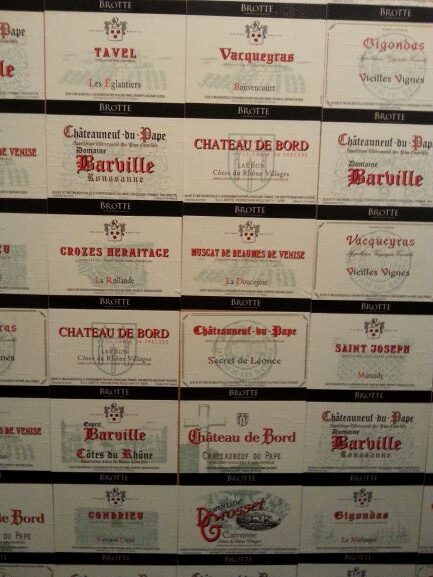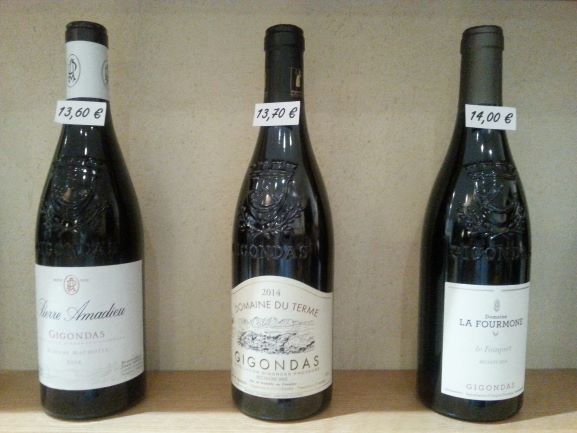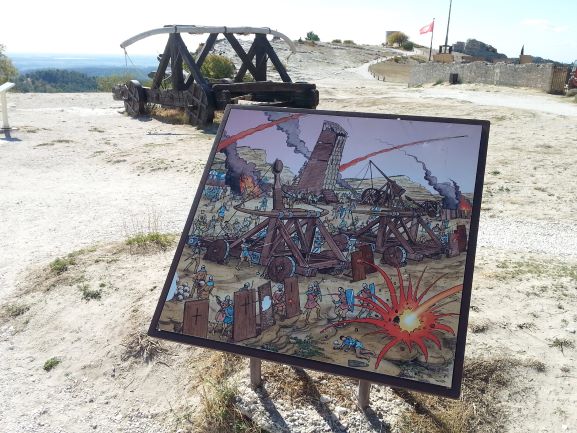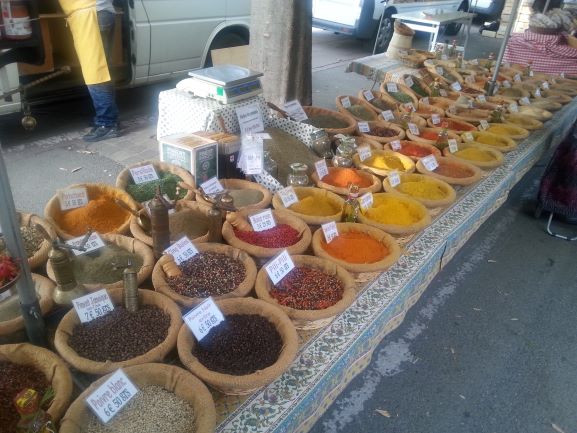Wine and Salt Mines
About a half-hour car ride from Avignon is the village of Châteauneuf-du-Pape. If you’re a wine lover, you’ve surely heard of it. Châteauneuf-du-Pape and the surrounding area produces some of the most renowned (and expensive) wines in the world.
Everyone from Charles Emerson Winchester III in M*A*S*H to the Beastie Boys has espoused the virtues of the sweet nectar from the grapes in this famous region of France. But, surprisingly, you can find bottles of this coveted wine for fairly reasonable prices.
A Short History
In 1309 a schism fractured the Catholic Church and popes, who were normally seated in Rome, resided instead in Avignon. The dispute wasn’t fully settled for over 100 years. The next seven popes were French, living in Avignon at the gigantic Pope’s Palace.

It was during the time of this so-called “Avignon Papacy” that Pope John XXII had a castle built on the hill of the backwater village now known as Châteauneuf-du-Pape, or the Pope’s new castle.
The Avignon Popes preferred the wines of Burgundy, further to the north, but winemaking did improve during this period. After the popes went back to Rome, the castle was left to crumble and Châteauneuf-du-Pape and its wines were largely forgotten.
As wine storage and shipping methods improved in the 19th century, so did the profile of the wines from Châteauneuf-du-Pape until the phylloxera blight killed most of the vines in France.
In 1868, a nearby landowner went to Rome asking for relief. He returned with some of the bones (allegedly) of St. Valentine. La Festo di Poutoun (Lover’s Festival) still takes place every year around Valentine’s Day in Roquemaure.

Then, in 1923, the wines of Châteauneuf-du-Pape received a boost. The area was given an AOC (appellation d’origine controlee) designation. This meant that only grapes grown in the region could be used in Châteauneuf-du-Pape wine. It also meant that these wines had to adhere to strict standards, including what types of grapes could legally be grown in Châteauneuf-du-Pape. Currently, 18 varieties are allowed. The most common grape varietal is Grenache.
In addition, AOC regulations outline where grapes may be grown. The village of Châteauneuf-du-Pape is so protective of its viticulture industry that in 1954 an ordinance was passed prohibiting the landing of flying saucers in the area. E.T. stay home.
AOC rules are in place to protect consumers who can look at a label and supposedly tell the quality of a bottle of wine (similar AOC regulations are also in place in France for products like cheese, meat, butter, and even lentils). In reality, these regulations do more to protect the producers. With the AOC restricting where crops can be grown and how they are labeled, less competition can enter the market. Someone from Normandy, for example, can’t slap a Châteauneuf-du-Pape label on their wine. But I also know producers in some of these regions who are foregoing the AOC labels and creating new and interesting products outside the limitations of the AOC government system.
Wine Tour

Your first stop in Châteauneuf-du-Pape should be the wine museum at the Brotte Winery. Some folks have complained that the museum is really just a vehicle to sell you wine. I’d argue that the museum is well laid out, informative (they have an audio guide available) and has dozens of wine making artifacts including a press from the 16th century. Of course the folks at Brotte want to sell you wine, but we never felt pressured to buy and were offered free tastings of as many of the wines as we liked.
The most interesting wine produced at Brotte is the La Fiole du Pape. The unique curved bottle debuted in 1952 and today has a faux dust covering. The red wine inside is very good and you can find it at high end wine shops in the States for $30-40.
Don’t limit yourself to one winery. There are over 300 vineyards and almost 200 wineries in the area.

Just outside of Châteauneuf–Du-Pape in the Gigondas AOC region is Moulin de la Gardette, an organic winery of great renown. Although I don’t think they have a distributor in the US, I have seen their wines available online. The tasting room décor won’t impress you, but the wines surely will.
Of course at any winery you visit there will be bottles for sale at astronomic prices. But, you can find excellent wines here for under $30. Some for under $20. If you’ve priced Châteauneuf–Du-Pape in the states, you know that’s a bargain.
It’s true anywhere, but remember, no drinking and driving. If you’re going to taste wines, have someone else do the driving. You can get the bus from Avignon to Châteauneuf–Du-Pape. It takes about a half hour and costs around $3. But, once you’re there it will be difficult to get to some of the wineries outside the village, although there are plenty of tasting rooms in town. Another option is to hire a driver. This can be a good investment, especially if you’re traveling with a group. There are also tours you can book; stop by the tourist office for info.
Buying & Transporting Wine

I don’t spend a lot of money shopping when I travel. Some little trinkets to give as presents or as keepsakes are about it. But, I will splurge on wine. Here’s my tip. In Europe you can often buy high-end wine direct from the producer for much less than you will pay in the states. You’ll be tempted to buy some wine and ship it back. Be careful. You’ll likely pay more when you factor in the shipping cost than you would buying the bottles back home. Why not grab one or two bottles and have a picnic (don’t forget the bottle opener!).
Here’s what you do. Pull that supercomputer out of your pocket, tap a few keys and look up whether the wine in question is available in the US. If it is, pass on shipping it, unless you’re getting an unbelievable deal. I usually only consider shipping wines from Europe when I cannot get a particular bottle in the States.
As an alternative, you can bring you newest favorite bottle with you in your checked luggage. One bottle (or 3 if you’re a couple) is duty free, but if you’re willing to pay the duty (usually $1-2 per bottle), you can bring as much as you want, as long as it’s for personal consumption. But, keep this in mind. Wine bottles are heavy. Pack too many and you may go over the weight limit. I had to part with a bottle in the airport once because my heavy bag was going to cost me an extra $125!
And, consider this. If your winery visit is at the beginning of your trip, do you really want to schlep heavy wine bottles all over Europe for the rest of your vacation?
Finally, pack well. There are products out there like specially designed bubble wraps shaped like wine bottles to help you get your wine home safely. For me, I usually just wrap them in dirty clothes (I’ve got plenty of those by the end of the trip) and don’t overload the suitcase. If you travel with a backpack, you might want to consider a hard sided suitcase to transport your grapey goodness. Although I’ve put a couple bottles in my backpack and never had a wine bottle break (fingers crossed).
Châteauneuf–Du-Pape is a small town, but there are places to stay. Especially attractive are the spots just out of town among the vineyards. Hostellerie Chateau des Fines Roches has rooms in a castle with a restaurant and, of course, an excellent selection of wines. Or, if you want to learn from a real master sommelier and former owner of a Michelin recognized restaurant, stay at the Wine B&B. There are only a few rooms, so book early.
Avignon
Avignon is a much larger town than Châteauneuf-du-Pape which makes it an excellent home base for your visit. There is good train and bus service, lots of hotels, and things to do. First on your list should be the Pope’s Palace. It still blows my mind that seven popes were stationed here in the 14th century. They had an imposing Gothic castle built which wasn’t nearly as impressive as the Vatican, but is still awe-inspiring.
The Avignon Festival is held here every July as are many exhibitions and conventions. The chapel on the second floor of the Saint-Jean tower has a series of paintings by Matteo Giovanetti depicting the life of Saint Martial.
When we visited Avignon we were lucky enough to see Les Luminessences d’Avignon. Films telling historical stories of France were projected a full 360 degrees around the courtyard of the palace. It was an incredible experience that gave us the feeling of being full immersed in medieval France. Bruno Seiller created the spectacle using a technique he calls “video mapping.” The show played for three years in Avignon’s Pope Palace, but sadly, has closed.
Bruno, the creator of Les Luminessences d’Avignon, has created a new program at Mont Saint Michel. It is open nightly.

Pont Saint-Bénézet aka Pont d’Avignon is known to every schoolchild who sung “Sur le Pont d’Avignon.” The 12th century bridge was rebuilt several times due to portions washing away during the frequent flooding of the Rhône. Finally giving up a losing battle, there are only four surviving arches on the bridge that stops halfway across the water. Sit on the grass on the banks of the Rhône and enjoy a nice picnic if you can block out the traffic noise. Or, for five Euro, you can walk on the bridge while you sing the song.
If you only visit one church in Avignon, make it the Basilique Saint-Pierre. The extravagantly ornate Gothic church was built in the mid-14th century on the site of a 7th century church. The stately façade is imposing and impressive, but the carved walnut doors steal the show. If you can go inside, you’ll marvel at the alter but don’t miss artwork in the side chapels.
Les Papalines d’Avignon
This is Provence, so the best food is seasonal. Look for asparagus in the spring, pistou (vegetable soup) in the summer, and butternut squash soup in the fall.
But, all year round you can find the unique local candy Les Papalines d’Avignon. The little chocolates are identifiable by their pink chocolate outer shell. Inside is another shell of chocolate hiding a splash of herbal liqueur. Although it’s called oregano liqueur, it is actually made by infusing forty herbs into the liquor, including oregano, but also sage, verbena, thyme, and many others. This gives the candy a lovely bitterness that offsets the sweetness of the chocolate nicely.
You can only buy Les Papalines d’Avignon from authorized shops, so it may be a little difficult to find. Patisserie Mallard was famous for their Papalines d’Avignon, but, sadly, they have closed. Jouvaud has several locations including one in Avignon and they carry Les Papalines d’Avignon.
Baux de Provence
We were so taken with Les Luminessences d’Avignon that we went to Baux de Provence, a medieval village about 40 minutes away by car (a bus runs to Baux from Avignon in the summer). Here, a former limestone quarry has been transformed into an incredible audio visual art space called Les Carrières de Lumières. Since 2012 they’ve been creating films of famous artists’ work and projecting them on the walls of a giant limestone room at the quarry. Pieces of art float, break apart, and transform into new pictures on the thousands of square meters of rock walls.
Loud music, from Vivaldi to Led Zeppelin, plays inside Les Carrières de Lumières as you wander what are essentially open air rooms. Every few feet is a new spectacle to steal your attention. If you go, you might want to bring a sweater or a light jacket. It’s chillier in the (man-made) cave than outside by several degrees.

After the sight and sound sensory overload of Les Carrières de Lumières, hike up the hill to the medieval town and castle of Baux de Provence. Your Les Carrières de Lumières admission entitles you to a discounted admission. You’ll be joined by other tourists (about 1.5 million visit Baux annually), but it’s worth it to trek up the road past the touristy cafes and souvenir shops to the flat rocky top for the incredible view. There are replicas of catapults which launch demonstration missiles during the summer, but be sure to keep walking to the far end of town where you can climb a turret. A flag flies at the top and this is where you can get the absolute best view in all of Baux. This is a great spot for your selfie with your GoPro or camera.
Arles
Arles is a quick train ride from Avignon. Fans of Vincent Van Gogh will know that the painted created several of his masterpieces while residing in Arles including The Yellow Room, Starry Night Over the Rhone, and L’Arlésienne among others. You can see many of the places in the city where the master set up his easel and painted by following The Van Gogh Walking Tour which has panels at ten significant sites including where Starry Night Over the Rhone was painted. There aren’t any original Van Gogh canvases in Arles, however.

While some of the locations that Vincent painted are no longer standing (Restaurant Carrel and The Yellow House, for instance), others can still be viewed and visited. The Espace Van Gogh is the former hospital where part of the master’s ear was reattached. It is also where he was later committed. It is now a museum/shrine of sorts where the garden has been planted to closely resemble the painting Le Jardin de l’Hôtel de Dieu.
Foundation Vincent Van Gogh, while not an historic site associated with the artist, is worth a visit for the Van Gogh inspired paintings it has on display.
When you’ve tired of chasing Vincent’s ghost, visit the Arles Saturday farmers market. It is one of the finest all of France, and that’s saying something.
Butternut Squash Soup Recipe
This is a traditional Provencal dish available in the fall. There are lots of variations on this soup, but this is my favorite. Make sure the butternut squash you select is ripe. Look at the top of the fruit; you want squash with no green stripes or faint green stripes near the stem. Be very careful when cutting the squash, it can roll and you can cut yourself badly.
Ingredients:
1 medium to large butternut squash
½ pound potatoes
½ yellow onion, diced
1 pear, peeled, cored, and diced
5 ounces crème fraiche (or heavy cream)-optional
32 ounces vegetable stock or water
3 tablespoons olive oil, divided
1 teaspoon herbs de Provence
Croutons
Salt and pepper
Grated nutmeg-optional
Preheat oven to 375°
· Peel and cube potatoes and place in a roasting pan with ½ tablespoon of olive oil. Sprinkle with salt and toss.
· Cut butternut squash in half lengthwise (being careful not to cut yourself) and remove seeds. Brush cut sides with 1 tablespoon of olive oil and sprinkle with salt. Place cut down in a roasting pan coated with an additional ½ tablespoon of olive oil. Place both pans in the oven.
· Check potatoes after 20 minutes for tenderness and remove from oven if done. Roast butternut squash for an additional 30-45 minutes until fork tender and remove from the oven when done to cool.
· Heat remaining olive oil in a Dutch oven and add onion. Cook for 5 minutes over medium heat until translucent. Add pears and cook an additional 5 minutes (pears needn’t be soft).
· When the squash is cool enough to handle, remove the stem and skin and discard. Add the squash flesh and potatoes to the onion mixture.
· Add the vegetable stock (or water) and herbs de Provence to the onion, pear, squash, and potato mixture and bring to a boil. Reduce heat and simmer for ten minutes until the pears are soft.
· Add optional crème fraiche and puree until smooth with an immersion blender.
· Garnish with croutons and cracked pepper. Grate fresh nutmeg on top, if desired.
Note: If you eliminate the stock, croutons, and crème fraiche from this recipe and just puree all the ingredients together after cooking them, it makes an excellent ravioli filling.
Transportation
Marseille Provence Airport
Avignon has an airport, but has few flights. The Marseille Provence Airport has regular arrivals from Europe, the UK, Africa, the Middle East, and Korea.
Vitrolles Train Station
Train station at the Marseille Airport with frequent service to Avignon.
Impasse Thalès, Zac de la, 13127 Vitrolles, France
Local transportation
Avignon has two train stations, one in the center of town and a high speed TGV station with access to cities all over France and the rest of Europe. If you’re visiting the towns around Châteauneuf–Du-Pape and Gigondas, you’ll need to rent a car, hire a driver or sign up for a tour
Bus and Tram
The bus and tram system is operated by Orizo.
Baladine
Funky little cars that run on a loop throughout the tourist area of Avignon. Flag one down and buy a ticket from the driver.
Bikes
Avignon has hundreds of bikes for rent in racks all over the city. Operated by Velopop.
Index of Things to Do in Châteauneuf–Du-Pape
Tourist Office
Great place for information about wineries, tours, and other activities in Châteauneuf–Du-Pape.
3 Rue de la République, 84230 Châteauneuf-du-Pape, France
Popes Palace
Home of the Popes during the 14th century. This amazing Gothic palace in Avignon hosts special events and exhibits during the year.
Pl. du Palais, 84000 Avignon, France
Brotte Winery
Famous winery with a museum featuring antique winemaking equipment.
Av. Saint-Pierre de Luxembourg, 84230 Châteauneuf-du-Pape, France
Moulin de la Gardette
Excellent winery in Gigondas
11 Pl. Gabrielle Andéol, 84190 Gigondas, France
Pont Saint-Bénezet
The famous Avignon Bridge. Dance on the bridge, sing the song, and relive your childhood.
Bd de la Ligne, 84000 Avignon, France
Basilique Saint-Pierre d’Avignon
Extraordinary Gothic church
Rue Saint-Pierre, 84000 Avignon, France
Les Carrières de Lumières
A fantastic, immersive film of master artworks projected on the walls of an abandoned stone quarry in Baux de Provence.
Route de Maillane, 13520 Les Baux-de-Provence, France
The Van Gogh Walking Tour
Self-guided tour in Arles showing the locations where several of Van Gogh’s masterpieces were painted.
1 Rue de la Commune, 13210 Saint-Rémy-de-Provence, France
Café de la Gare
Where Vincent Van Gogh painted The Night Café, 1888. The cafe, of course, is long gone.
Espace Van Gogh (Arles)
Former hospital where Vincent’s ear was reattached now has a garden planted to resemble Le Jardin de l’Hôtel de Dieu.
Pl. Félix Rey, 13200 Arles, France
Foundation Vincent Van Gogh Arles
Museum with several Van Gogh inspired pieces.
35 T rue du Docteur Fanton, 13200, Arles
Outdoor Market
One of the best in all of France. Saturday only.
Bd. des Lices and Bd. Georges-Clémenceau, Arles
Index of Food & Drink in Châteauneuf–Du-Pape
Hostellerie Chateau des Fines Roches
Beautiful castle setting for a hotel and Michelin recommended restaurant.
1901 route de Sorgues, 84230 Châteauneuf–Du-Pape, France
Le Verger des Papes
Perfect outdoor dining right next to the castle walls. Michelin recommended.
Au château, 84230 Châteauneuf-du-Pape
L’Agape
Michelin recommended restaurant with excellent food and lovely presentation.
21 Place des Corps Saints, 84000, Avignon, France
Les Halles
Fantastic farmers market.
Place Pie, 18, Avignon, France
Index of Places to Stay in Châteauneuf–Du-Pape
Hostellerie Chateau des Fines Roches
Stay in a castle just outside of Châteauneuf–Du-Pape.
1901 route de Sorgues, 84230 Châteauneuf –Du-Pape, France
The Wine B&B
Quaint B&B owned by sommelier Danièle Raulet-Reynaud
20 Av. Charles de Gaulle, 84230 Châteauneuf-du-Pape, France
Hotel Le Colbert
Great little hotel in Avignon with an adorable courtyard where breakfast is served.
7 rue Agricol Perdiguier, 84000, Avignon, France
Hotel d’Europe
Luxury hotel in the middle of Avignon with a nice bar and restaurant.
12 Place Crillon | Catégorie: en cours de Classement, 84000, Avignon, France
About the Author

Brent Petersen is the Editor-in-Chief of Destination Eat Drink. He currently resides in Setubal, Portugal. Brent has written the novel “Truffle Hunt” (Eckhartz Press) and the short story collection “That Bird.” He’s also written several Foodie Travel Guides to cities in France including Lyon and Bordeaux. Brent’s podcast, also called Destination Eat Drink, is available on all major podcasting platforms and is distributed by the Radio Misfits Podcast Network.
